Introduction
This page has been set up to share items of interest about RAF Spilsby in the life of the local community, provided by local people past and present, items appearing in the local media, and from those who served there, especially on 207 Squadron.
If you have material you can share with us about 207 Squadron (or 44 Squadron, and later 75 Sqn) when stationed at RAF Spilsby, please write to the editor, Frank Haslam, 56 Windfield, Leatherhead, Surrey KT22 8UQ, or email
11 Nov 2007 Remembrance SundayThis year Fred Pearce laid a wreath bearing the 207 Squadron crest, on the Spilsby War Memorial. Indeed, Renee Pearce was really proud that Fred also marched in the Veterans parade to the Church, this not long after his knee surgery. The wreath also bears the inscription "In memory of the 510 airmen of 207 Squadron and 89 airmen of 44 Squadron who died whilst serving at RAF Spilsby". We acknowledge with our thanks that the wreath was provided by the Spilsby Branch of the Royal British Legion. During the Remembrance Service itself, Canon Peter Coates also included No.207 and No.44 Squadron's numerical losses during the reading of Names of those who died. After the wreath-laying there was a lot of positive and appreciative comments from locals on a 207 wreath being laid on the town's War Memorial this year (as far as could be recalled, for the first time) and on Fred's involvement. An Association wreath has been at the Airfield Memorial, together with one in respect of Sgt Richard Gaut kia 16/7/44, plus some RBL crosses. |
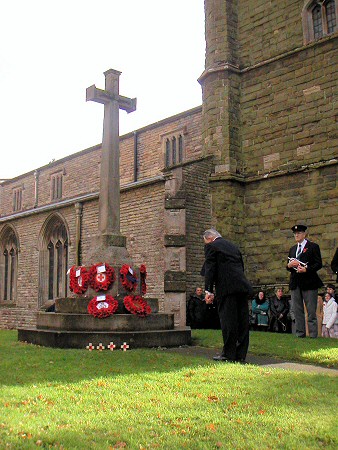 |
Raymond Glynne-Owen writes 1 June 2006
The brambles which had previously prevented me gaining access to the Operations Block not far from the Memorial had died back during the winter. In April I was able to take some side views and an interior shot:
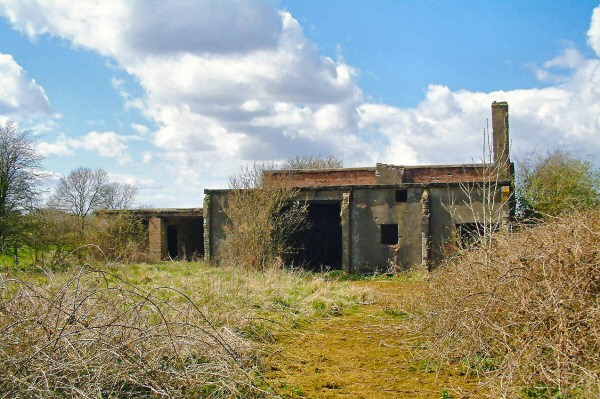
Spilsby Ops Block, 11 April 2006
Another view - Spilsby Ops Block, 11 April 2006
Incidentally, the concrete over the main Ops block building was supposed to be a single slab. However, insufficient concrete was delivered when it was being laid, it is in fact 2 slabs! (info from one of the contractors' site management team, to whom I spoke last year).
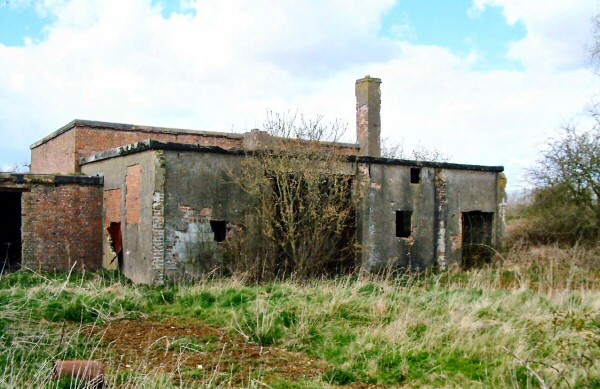
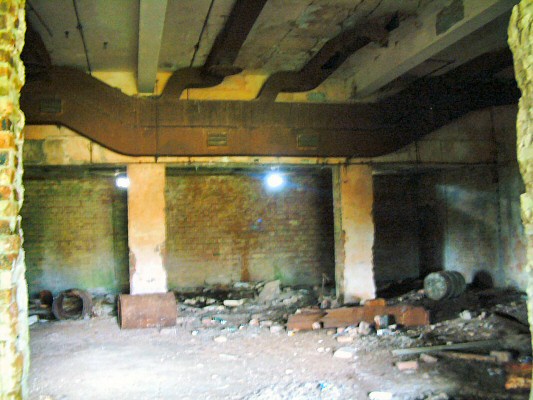
Spilsby Ops Block: interior shot showing the ventilation
ducting is still in place: 11 April 2006
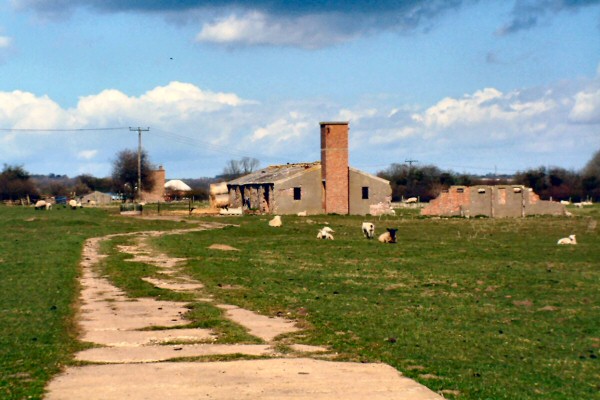
1. 2006: View of the remaining buildings on Dispersed Site
No.2: the main building shown is Building No.733
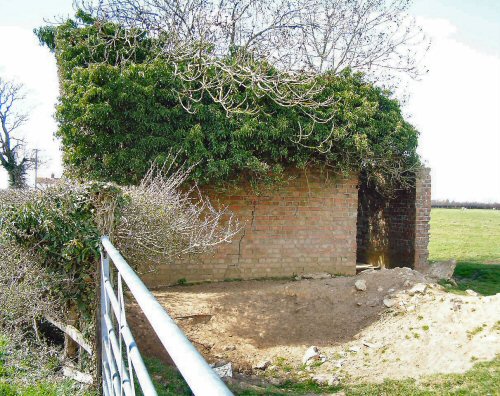
2. 2006: The remains of the Picket post at the entrance to
Dispersed Site No.2
(interestingly, it is not shown on the airfield Dispersed
Sites plan)
| 3. 2006: Hangar No.2, which still stands on the
north side of the airfield near the Monksthorpe
chapel. This hangar is incorrectly shown on the airfield site plan as a Type T2, it is in fact a Type B. The 600 still displayed on its relates to its use some 20 years ago by a company of that name which was then building air-conditioned Nissen huts for the Oil industry in the Middle-East in the hangar . It is now used for farm equipment storage. |
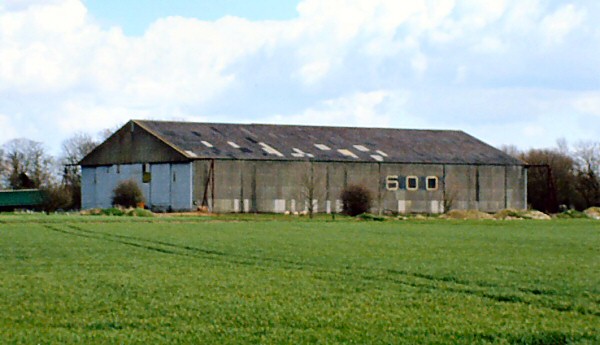 |
Kevin Mapley writes 12 Apr 2006
The Spilsby memorial is once again looking in good shape. [Editor: some frost damaged brickwork has been repaired]. The rain was intermittent (damn cold) and as a consequence Friend Member Roger Aston will finish the last bits and pieces. The carpentry on the notice board was completed along with a fresh coat of paint, hopefully no more leaks. Fred Pearce came down to edge the grass and help smarten things up for the anniversary of the bomb dump explosion.(Easter Monday 1944) A crowd of about twenty people witnessed Ken Smith lay his wreath at 8pm on the evening of 10 April. Roger Aston had made prior arrangements with Association member Rev. Harry Orchard to carry out a short service at the memorial.
This poignant moment was shared with John Pearl (AG) whose skipper was lost exactly one year later, to the day when they were shot down bombing the railway yards at Wahren, Leipzig [ME472 EM-O]. Flt Lt Peter Anderson RCAF was the last 207 Squadron casualty of the war. There were four 207 veterans present. [Editor: we hope to be able to give wider notice of this event next time so that more members and local people can attend. We are all grateful to Kevin and the team who faithfully maintain this increasingly visited memorial.]
Raymond Glynne-Owen writes 9 Apr 2006The local Newspaper is running a series of articles on Wartime RAF Spilsby, drawing from a narrative and various selected photos that I have provided them with. [Raymond was recently elected Chairman of the Spilsby Local History Society]. |
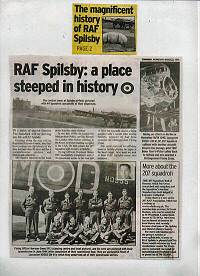 |
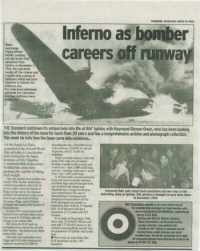 |
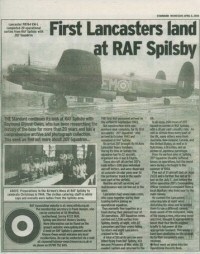 |
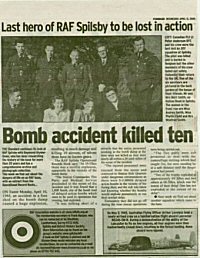 |
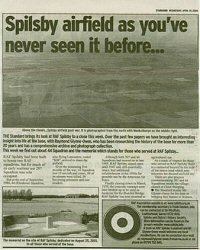 |
Here is a rather nice picture used in one of the articles, dated on the front as 22 October 1944 and captioned "Harvest Festival Decoration". On the back of the photo is handwritten "Spilsby Church". I have shown and discussed the photo with Canon Peter Coates, Vicar of St James's church in Spilsby, and we are certain it was not taken inside St James's. I have been told the Gymnasium (building 416 on Communal Site No 2) was used as the station church, so the photo is presumably showing the inside of this building. If anyone can comment on this picture and location please contact the editor.
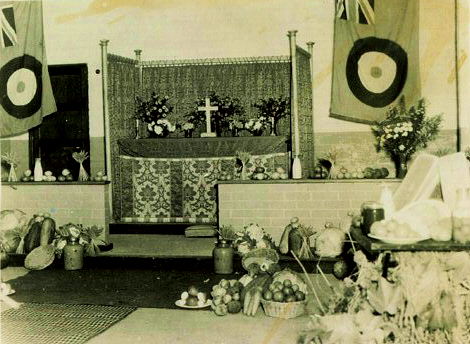
207 Squadron Association Secretary Kevin Mapley has been heavily involved with the creation and maintenance of the Spilsby airfield memorial, as were members Ron Winton, Sheilagh Wilford and the late Ron Emeny - see the Memorial Detail and Dedication links. A number of local people keep an eye on the memorial and from time to time working parties are held. We are very grateful for the help from the community and from 2266 (Spilsby) ATC Squadron.
In 2004 Kevin also provided the displays of photos now in the Franklin Hall.
September 2005: The Dinghy Store (building 553) still standing on Spilsby's main site(Glynne-Owen)
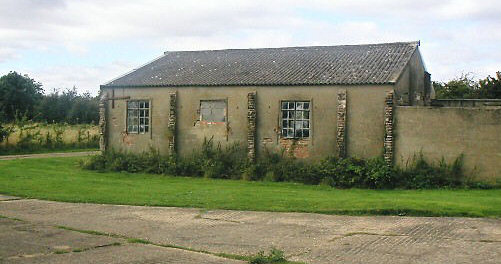
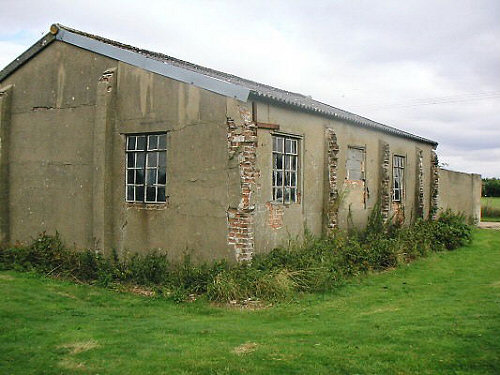
Local Target Series newspaper July 13 2005
[Raymond Glynne-Owen, Honorary member of 207 Squadron RAF Association, now lives in Spilsby. He has given talks on the aerodrome to local groups and this attracted the interest of a local reporter.]
"A historian is asking people for their recollections of RAF Spilsby, a former Royal Air Force base which was an operational base for the RAF's Bomber Command during the Second World War.
Raymond Glynne-Owen, who is an RAF archivist, is hoping to help write a book about the aerodrome, which is to be published by the 207 Squadron Association, if it can gather enough information about the aerodrome. [editor - the information may (also) be better published on the web as it is expected that this will generate more feedback; the amount of material will probably exceed that which can be economically published as a book.] The information will also be used to help the Spilsby History Society to compile a record of the aerodrome.
207 Squadron was the first bomber command squadron to be based at the aerodrome; soon after it was completed in October 1943 until the end of the war in May 1945.The other squadron to be based at the aerodrome was 44 (Rhodesia) Squadron, which arrived in October 1944."
"Mr Glynne-Owen said some traces of the former aerodrome still remain, although some of the runways have been broken up (the concrete has been used to help build the foundations of the Humber Bridge). He added: "There are quite a few traces of the aerodrome left, if you know what you are looking for There are quite a few taxiways left (which ran around the perimeter of the aerodrome), and a bomb disposal area is still identifiable.''
"He said that some local people have already contributed their memories of the aerodrome including their recollections of an explosion in a bomb storage area which killed 10 armourers and a mid air collision between two bombers."
|
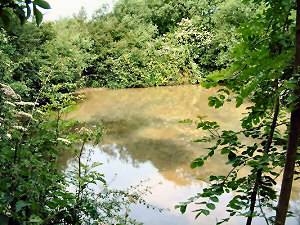 pond on the site of one of the bomb dump buildings |
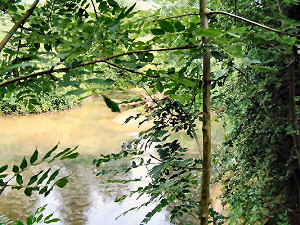 |
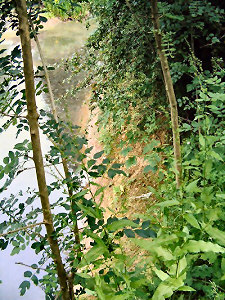 note straight edge to this side of pond |
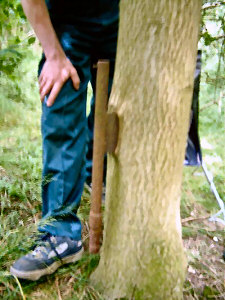 could this be debris from the bomb dump explosion? |
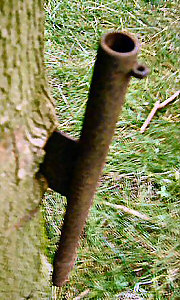 another view of the mystery object - a rod nearby fits it |
"He became interested in the aerodrome because his late uncle, Norman Owen, a pilot officer, was stationed there during the war. He completed a total of 36 operational sorties during the period January to June 1944, which was an unusually high tally. Some aircrews completed 30 sorties, but tragically many were killed in action before they reached that figure.
Mr Glynne-Owen is Welsh, and his uncle, like many Welsh people, was of the Baptist faith. He said that his uncle, because of his faith, was one of the few aircrew that did not drink alcohol, and while other aircrew would be drinking in the local pubs he would be playing the organ at the local Baptist chapel. He added that one local resident said that he clearly remembers his uncle doing this, despite the passing of the years."
"Mr Glynne-Owen is an archivist for Bomber Command, and he has helped several other RAF associations, as well as 207 Squadron Association, compile Roll of Honours for example. He has been visiting Spilsby for the past 20 years, and liked it so much that he settled in the town about eight months ago.
If anyone can help Mr Glynne-Owen he can be contacted on Spilsby (01790) 752845, while the 207 Association's website, which contains more information about RAF Spilsby, can be found at www.rafinfo.org.uk "
from the Summer 2005 207 Squadron RAF
Association newsletter
Raymond Glynne-Owen has facilitated East Kirkby’s
section on the Squadron by correcting and updating the
displays in the hangar about which a number of members had
noted there were some mistakes. [Editor - 2013 visit: These
displays are now presented in very large folders in the
hangar.]
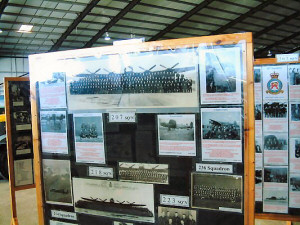 |
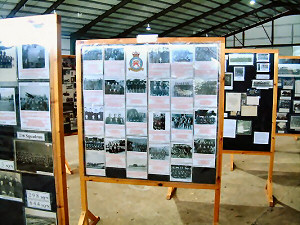 |
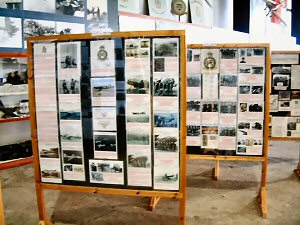 |
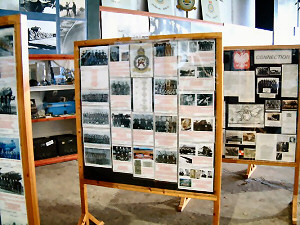 |
He also assisted the outfitters in Spilsby [Smalls' Outfitters, on behalf of the British Legion] to create a window display about 207 Squadron for the week of the 60th anniversary of VE Day. This proved very successful and quite a talking point locally. |
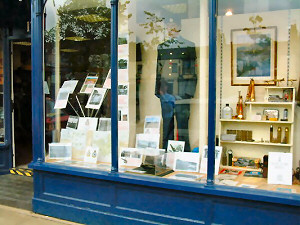 |
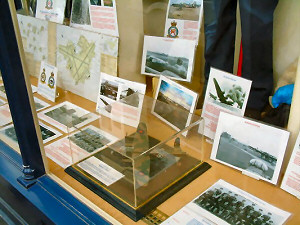 |
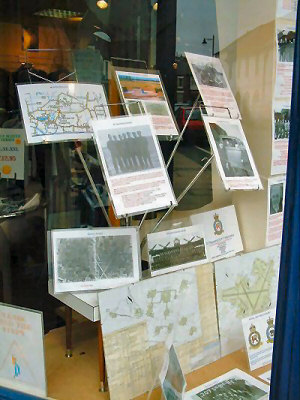 |
207 Squadron RAF Association Newsletter Winter 2004
Raymond writes: UK members might be interested to know that the BBC's Songs of Praise programme on February 6th will include an item on Monksthorpe Baptist Chapel.
The chapel was built in 1701 as a meeting place for Baptists, whose worship was illegal under Charles II's Conventicle Act of 1664, hence it was disguised as a barn in its outward appearance. It is now owned by the National Trust, who restored it from a derelict state.
The significance of the chapel to the Association is of course that it lies directly behind the sole remaining Hangar on the north side of the-now disused Spilsby airfield and is located adjacent to where the bomb dump was.
Those wartime members of 207 Squadron and RAF Spilsby of the Baptist faith would obviously have made use of the Chapel. It is also of special family interest to me since it is where my uncle, Norman Owen DFC, exercised his self-taught organ-playing skills during his off-duty moments January-June 1944!
links
207
Squadron RAF Association - Spilsby Airfield Memorial
RAF Spilsby - Richard Caville's site
Robert Truman's site on Spilsby Airfield
Map of the
Spilsby area - Map of the Great Steeping/airfield area
Spilsby
Town
last update 29 Nov 2007: 2 Jan 14